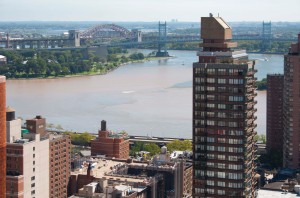By Vladimir Brezina
In my last post I wrote about paddling from Manhattan down to Sandy Hook, NJ. But paddling down is the easy part. It’s on Sandy Hook that unsuspected dangers lurk.
I remember a Sandy Hook trip of some years ago. (OK, I’ve just looked it up in my records and it was in September 2000—eleven years ago. How time flies…) Erik Baard and I paddled down from Manhattan and landed on the beach near the northwestern tip of Sandy Hook. We had a leisurely lunch, took a stroll along the beach, lazed about, and after a couple of hours were ready to paddle back to Manhattan. But just before we launched, we thought that we might, just out of curiosity, find out what those two big signs that stood there, facing away from us, said…
 (I’ve never landed on that part of the beach since :-) But I’ve paddled past many times, and haven’t seen those signs again. The Coast Guard has probably relaxed its grip somewhat. Still, many parts of Sandy Hook remain restricted for one reason or another.)
(I’ve never landed on that part of the beach since :-) But I’ve paddled past many times, and haven’t seen those signs again. The Coast Guard has probably relaxed its grip somewhat. Still, many parts of Sandy Hook remain restricted for one reason or another.)
.
.
.
 In the meantime, on the opposite, eastern side of Sandy Hook, there is another set of signs…
In the meantime, on the opposite, eastern side of Sandy Hook, there is another set of signs…
These signs mark the notorious Gunnison Beach:
In 1999, New Jersey passed a law that allows municipalities and counties to prohibit all types of nudism on state or local beaches in their jurisdiction, making Gunnison Beach the only legal nude beach in the state, since it is on federal land not subject to state or municipal regulations. Also, since there is no law against alcohol on federal lands drinking is allowed. Gunnison is the largest clothing-optional recreation area on the East Coast. The clothing optional beach, which offers dramatic views of Brooklyn and the Verrazano Narrows Bridge, attracts nearly 5,000 naturists per weekend in the summer months. Part of the beach is shared on a seasonal basis with a reserved breeding ground for the endangered Piping Plover, a native shore bird.
(Who says that Wikipedia doesn’t have a sense of humor?)
Sadly, every time I’ve paddled past Gunnison Beach it’s been deserted, except for one or two men who may have been naked but who also were largely invisible behind the barriers they had to erect against the bitterly cold wind… Of course, that might have been because I’ve paddled on the ocean side of Sandy Hook mostly in the off-season. In the summer, the whole ocean side is patrolled by rangers who order any kayaker who attempts to land summarily back into the surf.
So, Sandy Hook is a dangerous, and fascinating, place. And I haven’t even mentioned the crumbling military ruins, the guns, the missiles, of Sandy Hook—that’s for another post!















